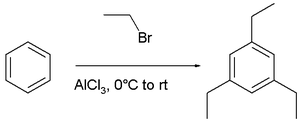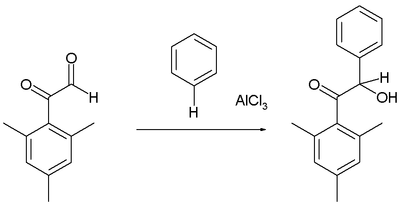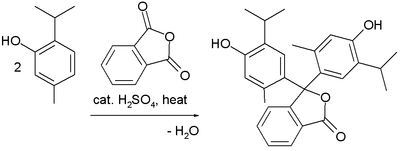مستخدم:عبد المؤمن/مسودات/تعادلات فريدل-كرافتس
تفاعلات فريدل-كرافتس مجموعة من التفاعلات العضوية، طوّرها تشارلز فريدل وجيمز كرافتس سنة 1877، لضمّ مستبدلات إلى الحلقات العطرية.[1]
وتنقسم تلك التفاعلات إلى نواعان رئيسيان: معادلات ألكلة There are two main types of Friedel–Crafts reactions: alkylation reactions and acylation reactions, both proceeding by electrophilic aromatic substitution. The general reaction scheme is shown below.
Several reviews have been written.[2][3][4][5]
Friedel–Crafts alkylation
[عدل]Friedel–Crafts alkylation involves the alkylation of an aromatic ring with an alkyl halide using a strong Lewis acid catalyst. With anhydrous ferric chloride as a catalyst, the alkyl group attaches at the former site of the chloride ion. The general mechanism is shown below.[6]
This reaction has one big disadvantage, namely that the product is more electrophilic than the reactant due to the electron donating alkyl-chain. Therefore, another hydrogen is substituted with an alkyl-chain, which leads to overalkylation of the molecule. Also, if the chloride is not on a tertiary carbon, carbocation rearrangement reaction will occur. This reactivity is due to the relative stability of the tertiary carbocation over the secondary and primary carbocations.[7]
Steric hindrance can be exploited to limit the number of alkylations, as in the t-butylation of 1,4-dimethoxybenzene.[بحاجة لمصدر]
Alkylations are not limited to alkyl halides: Friedel–Crafts reactions are possible with any carbocationic intermediate such as those derived from alkenes and a protic acid, Lewis acid, enones, and epoxides. An example is the synthesis of neophyl chloride from benzene and methallyl chloride:[8]
- H2C=C(CH3)CH2Cl + C6H6 → C6H5C(CH3)2CH2Cl
In one study the electrophile is a bromonium ion derived from an alkene and NBS:[9]
In this reaction samarium(III) triflate is believed to activate the NBS halogen donor in halonium ion formation.
Friedel–Crafts dealkylation
[عدل]Friedel–Crafts alkylation is a reversible reaction. In a reversed Friedel–Crafts reaction or Friedel–Crafts dealkylation, alkyl groups can be removed in the presence of protons and a Lewis acid. [بحاجة لمصدر]
For example, in a multiple addition of ethyl bromide to benzene, ortho and para substitution is expected after the first monosubstitution step because an alkyl group is an activating group. However, the actual reaction product is 1,3,5-triethylbenzene with all alkyl groups as a meta substituent.[10] Thermodynamic reaction control makes sure that thermodynamically favored meta substitution with steric hindrance minimized takes prevalence over less favorable ortho and para substitution by chemical equilibration. The ultimate reaction product is thus the result of a series of alkylations and dealkylations.
Friedel–Crafts acylation
[عدل]Friedel–Crafts acylation is the acylation of aromatic rings with an acyl chloride using a strong Lewis acid catalyst. Friedel–Crafts acylation is also possible with acid anhydrides. Reaction conditions are similar to the Friedel–Crafts alkylation mentioned above. This reaction has several advantages over the alkylation reaction. Due to the electron-withdrawing effect of the carbonyl group, the ketone product is always less reactive than the original molecule, so multiple acylations do not occur. Also, there are no carbocation rearrangements, as the carbonium ion is stabilized by a resonance structure in which the positive charge is on the oxygen.[بحاجة لمصدر]
The viability of the Friedel–Crafts acylation depends on the stability of the acyl chloride reagent. Formyl chloride, for example, is too unstable to be isolated. Thus, synthesis of benzaldehyde via the Friedel–Crafts pathway requires that formyl chloride be synthesized in situ. This is accomplished via the Gattermann-Koch reaction, accomplished by treating benzene with carbon monoxide and hydrogen chloride under high pressure, catalyzed by a mixture of aluminium chloride and cuprous chloride.[بحاجة لمصدر]
Reaction mechanism
[عدل]In a simple mechanistic view, the first step consists of dissociation of a chloride ion to form an acyl cation ("acylium ion")[بحاجة لمصدر]:
In some cases, the Lewis acid binds to the oxygen of the acyl chloride to form an adduct.[11] Regardless, the resulting acylium ion or a related adduct is subject to nucleophilic attack by the arene:
Finally, chloride anion (or AlCl4-) deprotonates the ring (an "arenium ion") to form HCl, and the AlCl3 catalyst is regenerated:
If desired, the resulting ketone can be subsequently reduced to the corresponding alkane substituent by either Wolff–Kishner reduction or Clemmensen reduction. The net result is the same as the Friedel–Crafts alkylation.[بحاجة لمصدر]
Friedel–Crafts hydroxyalkylation
[عدل]Arenes react with certain aldehydes and ketones to form the hydroxyalkylated product for example in the reaction of the mesityl derivative of glyoxal with benzene[12] to form a benzoin with an alcohol rather than a carbonyl group:
Scope and variations
[عدل]This reaction is related to several classic named reactions:
- The acylated reaction product can be converted into the alkylated product via a Clemmensen reduction.[بحاجة لمصدر]
- The Gattermann–Koch reaction can be used to synthesize benzaldehyde from benzene.[بحاجة لمصدر]
- The Gatterman reaction describes arene reactions with hydrocyanic acid[بحاجة لمصدر]
- The Houben–Hoesch reaction describes arene reactions with nitriles[بحاجة لمصدر]
- A reaction modification with an aromatic phenyl ester as a reactant is called the Fries rearrangement.[بحاجة لمصدر]
- In the Scholl reaction two arenes couple directly (sometimes called Friedel–Crafts arylation).[بحاجة لمصدر]
- In the Zincke–Suhl reaction p-cresol is alkylated to a cyclohexadienone with tetrachloromethane[بحاجة لمصدر]
- In the Blanc chloromethylation a chloromethyl group is added to an arene with formaldehyde, hydrochloric acid and zinc chloride.[بحاجة لمصدر]
- The Bogert-Cook Synthesis (1933) involves the dehydration and isomerization of 1-β-phenylethylcyclohexanol to the octahydro derivative of phenanthrene[13]
- The Darzens–Nenitzescu Synthesis of Ketones (1910, 1936)[14] involves the acylation of cyclohexene with acetyl chloride to methylcyclohexenylketone.
- In the related Nenitzescu reductive acylation (1936)[15] a saturated hydrocarbon is added making it a reductive acylation to methylcyclohexylketone
- In a green chemistry variation aluminium chloride is replaced by graphite in an alkylation of p-xylene with 2-bromobutane. This variation will not work with primary halides from which less carbocation involvement is inferred.[16]
Dyes
[عدل]Friedel–Crafts reactions have been used in the synthesis of several triarylmethane and xanthene dyes.[17] Examples are the synthesis of thymolphthalein (a pH indicator) from two equivalents of thymol and phthalic anhydride:
A reaction of phthalic anhydride with resorcinol in the presence of zinc chloride gives the fluorophore Fluorescein. Replacing resorcinol by N,N-diethylaminophenol in this reaction gives rhodamine B:
Haworth reactions
[عدل]The Haworth reaction is a classic method for the synthesis of tetralone.[18][19] In it benzene is reacted with succinic anhydride, the intermediate product is reduced and a second FC acylation takes place with addition of acid (see also: [1]).
In a related reaction, phenanthrene is synthesized from naphthalene and succinic anhydride in a series of steps.
Friedel–Crafts test for aromatic hydrocarbons
[عدل]Reaction of chloroform with aromatic compounds using an aluminium chloride catalyst gives triarylmethanes, which are often brightly colored, as is the case in triarylmethane dyes. This is a bench test for aromatic compounds.[بحاجة لمصدر]
See also
[عدل]- Friedel family, a rich lineage of French scientists
- Hydrodealkylation
- Transalkylation
References
[عدل]- ^ Friedel, C.; Crafts, J. M. (1877) «Sur une nouvelle méthode générale de synthèse d’hydrocarbures, d’acétones, etc.,» كومبت راند[الفرنسية] 84: 1392و 1450.
- ^ Price, C. C. Org. React. 1946, 3, 1. (Review)
- ^ Groves, J. K. (1972). "The Friedel–Crafts acylation of alkenes". Chem. Soc. Rev. ج. 1: 73. DOI:10.1039/cs9720100073.
- ^ Eyley, S. C. Comp. Org. Syn. 1991, 2, 707–731. (Review)
- ^ Heaney, H. Comp. Org. Syn. 1991, 2, 733–752.
- ^ قالب:March6th
- ^ قالب:March6th
- ^ W. T. Smith, Jr. and J. T. Sellas(1963)."Neophyl chloride". Org. Synth..
- ^ S. Hajra, B. Maji and S. Bar (2007). "Samarium Triflate-Catalyzed Halogen-Promoted Friedel–Crafts Alkylation with Alkenes". Org. Lett. ج. 9 ع. 15: 2783–2786. DOI:10.1021/ol070813t.
- ^ K. Wallace, R. Hanes, E. Anslyn, J. Morey, K. Kilway and J. Siegel (2005). "Preparation of 1,3,5-Tris(aminomethyl)-2,4,6-triethylbenzene from Two Versatile 1,3,5-Tri(halosubstituted) 2,4,6-Triethylbenzene Derivatives". Synthesis. ج. 2005 ع. 12: 2080–2083. DOI:10.1055/s-2005-869963.
{{استشهاد بدورية محكمة}}: صيانة الاستشهاد: أسماء متعددة: قائمة المؤلفين (link) - ^ قالب:March6th
- ^ R. C. Fuson, H. H. Weinstock and G. E. Ullyot (1935). "A New Synthesis of Benzoins. 2′,4′,6′-Trimethylbenzoin". J. Am. Chem. Soc. ج. 57 ع. 10: 1803–1804. DOI:10.1021/ja01313a015.
- ^ This reaction with phosphorus pentoxide: J. v. d. Kamp and E. Mosettig (1936). "Trans- And Cis-As-Octahydrophenanthrene". J. Am. Chem. Soc. ج. 58 ع. 6: 1062–1063. DOI:10.1021/ja01297a514.
- ^ Darzens-Nenitzescu Synthesis of Ketones
- ^ Nenitzescu Reductive Acylation
- ^ Sereda, Grigoriy A.; Rajpara, Vikul B. (2007). "A Green Alternative to Aluminum Chloride Alkylation of Xylene". J. Chem. Educ. ج. 2007 ع. 84: 692. Bibcode:2007JChEd..84..692S. DOI:10.1021/ed084p692.
{{استشهاد بدورية محكمة}}: صيانة الاستشهاد: أسماء متعددة: قائمة المؤلفين (link) - ^ McCullagh، James V.؛ Daggett، Kelly A. (2007). "Synthesis of Triarylmethane and Xanthene Dyes Using Electrophilic Aromatic Substitution Reactions". J. Chem. Educ. ج. 84: 1799. DOI:10.1021/ed084p1799.
- ^ Robert Downs Haworth (1932). "Syntheses of alkylphenanthrenes. Part I. 1-, 2-, 3-, and 4-Methylphenanthrenes". J. Chem. Soc.: 1125. DOI:10.1039/JR9320001125.
- ^ Name Reactions: A Collection of Detailed Reaction Mechanisms By Jie Jack Li Published 2003 Springer ISBN 3-540-40203-9
FC (Friedel–Crafts) reactions in Organic Syntheses
[عدل]- Alkylations:
- Diphenylacetone, Organic Syntheses, Coll. Vol. 3, p. 343 (1955); Vol. 29, p. 38 (1949) Article link.
- Reaction of p-xylene with chloromethane to durene Organic Syntheses, Coll. Vol. 2, p. 248 (1943); Vol. 10, p. 32 (1930). Article link
- Synthesis of benzophenone from benzene and tetrachloromethane Organic Syntheses, Coll. Vol. 1, p. 95 (1941); Vol. 8, p. 26 (1928).Article link
- Acylations:
- Dibenzoylethylene Organic Syntheses, Coll. Vol. 3, p. 248 (1955); Vol. 20, p. 29 (1940) Article link.
- reaction of acenaphthene plus succinic acid Organic Syntheses, Coll. Vol. 3, p. 6 (1955); Vol. 20, p. 1 (1940).Article link
- Desoxybenzoin Organic Syntheses, Coll. Vol. 2, p. 156 (1943); Vol. 12, p. 16 (1932). Article link
- Acylation of a phenanthrene compound Organic Syntheses, Vol. 80, p. 227 Link
- Reaction of bromobenzene with acetic anhydride Organic Syntheses, Coll. Vol. 1, p. 109 (1941); Vol. 5, p. 17 (1925). Article link
- beta-methylanthraquinone, Organic Syntheses, Coll. Vol. 1, p. 353 (1941); Vol. 4, p. 43 (1925). Article link
- Benzoylation of ferrocene Organic Syntheses, Coll. Vol. 6, p. 625 (1988); Vol. 56, p. 28 (1977). Article link
تصنيف:Substitution reactions
تصنيف:Carbon-carbon bond forming reactions
تصنيف:Name reactions















